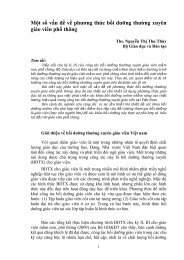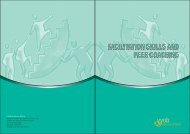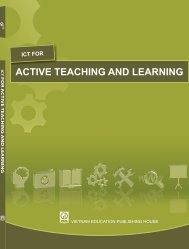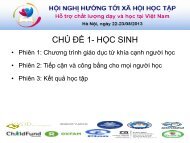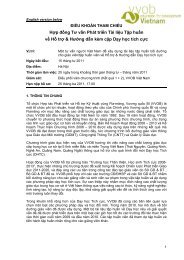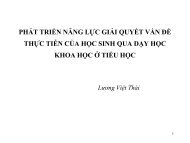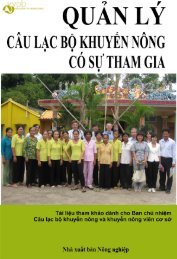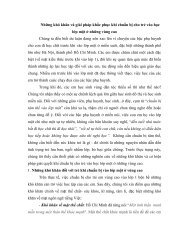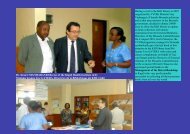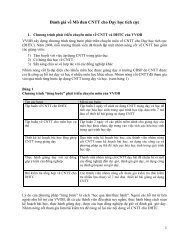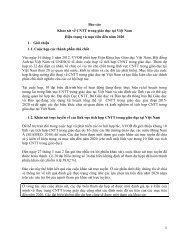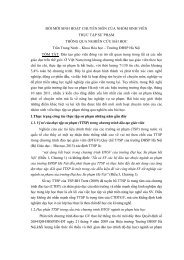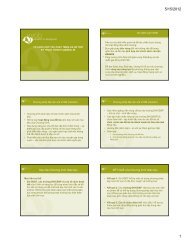KESSPDevelopmentObjectivePerformanceIndicatorBaseline(2005)Progress as atOctober 31, 2008G=Girls, B=Boys,T= Total2010 Target2: Enhancequality andlearningachievement.Difference NERlowest and highestdistrict<strong>Kenya</strong> Certificate ofPrimary Education(KCPE)<strong>Kenya</strong> Certificate ofSecondary Education(KCSE)Pupil-teacher Ratio(PTR) in publicprimary schools74.5 % points 67.6% point 40% pointsKCPEMean marks:171.16KCSE Number ofcandidates with C+or better (58,214)KCPEMean marks: 189.83KCSE > C 72,649Improved KCPEscore by 2% to250.5Improve by 20%(69,857)41:1 46:1 45:1Public primaryschools: class size60% above 50 40% above 50Eliminating classsizes > 50Pupil-textbook ratioEnglish, Math andScience 3:1 in bothlower and upperprimary levelsEnglish: 2:1 in lowerprimary; and for thethree subject areas 2:1for upper primary.1:1 per subjectTransition fromprimary to secondaryschools52.1% 70% 70%3. Provideopportunitiesfor furthereducation andtraining.Sub-sector strategiesNo sub-sectorstrategies weredeveloped, apartfrom primarySecondary, TIVET andUniversity Educationsub-sector strategieshave been developed,and operationalizationhas started4. StrengthenEducationSectormanagement.PTR at secondaryeducation levelPrimary educationshare of the budgetInterval betweenEMIS data collectionand publication57.4% (salary)18:1 20:1 21:114.7% non-salaryexpenditure52% (2008) due tosecondary educationexpansion;15% non-salary55% (salary)15% (non-salary)n.a. 18 months 6 monthsThe national school enrolment averages are masking serious regional disparities in terms of quality,efficiency and chances of access for poor children in general. Especially children in urban slums andthe ASAL areas are badly affected, and among those, girls the most.The <strong>Kenya</strong> education system can be described as ―preparation for exams”. National exams areoffered at the end of the primary (KCPE) and secundary cycles (KCSE). Although the nationalcurriculums are well developed, the teaching methods are mainly focusing on learning of facts that canbe replicated during the exams. The curricula include learning objectives in terms of transferable skills,life skills e.g., but since they are not examinable, they are neglected by the teachers and pupils showlittle interest. Student centred or practise based learning is hardly used. Most schools experienceshortages of didactic materials. <strong>Kenya</strong> is, since 2002, one of the countries tested, through theSouthern Africa Consortium for Monitoring Education Quality (SADMEQ), on “Learning Outcomes” forthe important skills (Mathematics, English and Sciences) and this for class four and six of the primarycycle. MOE is considering to intsitutionalise the testing of these learning outcomes, to supplement theKCPE exam.<strong>Kenya</strong> - <strong>Multi</strong>-<strong>Year</strong> <strong>Programme</strong> <strong>2011</strong>-<strong>2013</strong> 18/148
School principals have little or no influence on deployment and transfers of the teachers. There arefew mechanisms to influence the teachers‘ performance. The Directorate for Quality Assurance andStandards is understaffed and does not even manage to visit each school at least once a year. Theteachers‘ unions who are very powerful are constantly trying to improve the remunerations for theteachers. In the financial year 2010-<strong>2011</strong>, the government has factored in a salary increase.One approach to increase the quality of education is in-service. Various pilot programmes for primaryteachers and managers are now being harmonized in a national system. The School Empowerment<strong>Programme</strong> is being rolled out since 2009.Although pre-service training of teachers is not being abandoned, it is more effective for MOE tointroduce innovation through in-service training, especially in times where not many new teachers arebeing recruited. The country currently has 21 primary teacher training colleges, one diploma collegefor secondary teachers, various courses at universities for secondary teacher training. Specialisedteacher training is offered at the <strong>Kenya</strong> Technical Teachers Training College and the <strong>Kenya</strong> Institutefor Special Education.MOE struggles with low management capacity, and this at all levels, from headquarters to schools.Introduction of Free Primary Education and KESSP went hand in hand with decentralisation (todistricts and schools), requiring new management approaches and accounting systems. The variouscadres are still not sufficiently prepared; systems for communication, monitoring and evaluation arenot or only partially developed. The political habit of establishing new districts (nearly doubled in twoyears) has lead to deployment of unexperienced and unprepared officers. Most progress has beenmade regarding accountability. In 2008, the retirement age for civil servants was increased from 55 to60 years. This has brought some reprieve for MOE that has very few middle level managers withsufficient experience to grow to higher cadres. But the issue of ―succession management‖ still needsto be fully addressed.MOE was the first ministery to develop and implement an ICT strategy (National ICT Strategy forEducation and Training, June 2006) based on the National ICT Policy (March 2006). The Ministeryrecognizes that ICT can contribute to improved quality of education, especially in situations withincreased school populations. The <strong>Kenya</strong> Institute of Education (KIE) is developing digital, local,content for primary and secondary education.The National ICT Strategy en de e-Government Strategy stress the importance of integrating ICT inthe curriculums at all levels, to develop the country to a “knowledge-based economy” , as expressed in―Vision 2030‖. The ―human resources sector‖ to which education belongs still has to put in a lot ofeffort to reach these goals.An essential, ICT driven management tool, is the national Education Management InformationSystem. EMIS is crucial for the implementation of KESSP. Since 2009, efforts are being made tointegrate various databases (eg national exam results, teachers service commision data, secondarybursaries, enrolment data... ) into one.3.4. Transversal themes in the education systemKESSP (see 3.2.2) has separate investment programmes for HIV&AIDS and Gender. An ―Educationand Gender‖ Policy is being implemented since August 2007. There are special efforts to reduceprevalence among learners and teachers.Environment is not included in KESSP in a structural way, but it receives attention under theprogrammes for infrastructure development and school health, nutrition & meals. Under the ―Economicstimulus package” from the central government, additional funds have been allocated (in 2009 and2010) for tree planing in schools. This programme is implemented by the Ministry of Education.Environment is included in the curriculum, at various levels and subjects (e.g. life skills, sciences,agriculture, ...)<strong>Kenya</strong> - <strong>Multi</strong>-<strong>Year</strong> <strong>Programme</strong> <strong>2011</strong>-<strong>2013</strong> 19/148



